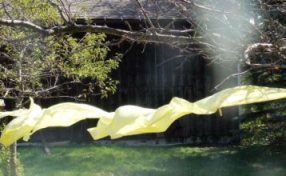We recently spent a glorious morning at the farm with some of the children and parents from Tree School, a parent cooperative preschool based at Milwaukee’s Urban Ecology Center.
We are blessed – or cursed, I guess, depending upon how you look at it – with acres of goldenrod at the farm, a plant that is plentiful all across the US, and blooms in August and September. When used in dyeing, goldenrod produces a lovely yellow color, perfect for capes for the Michaelmas season!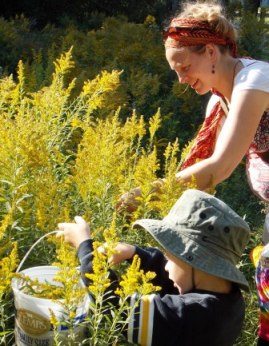
The morning was gorgeous – sunny and just slightly breezy – as we made our way to the field where the children and their parents picked the goldenrod flowers. If you are doing this at home, make sure to choose the bright yellow flowers and not get too many of the green stems, or you will have a greenish cast to your dye.
The flowers were added to the already simmering pot of water. An enamel or stainless, non-reactive pot is important to use when dyeing with natural materials. We crushed the flowers a bit with a potato masher, and then we set out on our walk.
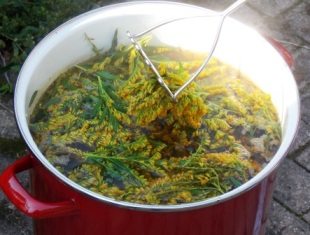
While the flowers were simmering in the pot, we took a hike to the old oak tree where we spread out our blanket and enjoyed our snack from the garden: carrots, cherry tomatoes, zucchini bread, and a cantaloupe that was so ripe and juicy, the bees found us immediately.
It was here at snack that I planned to tell the story of St. George and the Dragon, to introduce the idea of Michaelmas and the golden cape. We were running a bit behind schedule at this time, and we also had a bee sting….all in all, it seemed disrespectful to both the children and the story to try to cram in a puppet play right then, so I abandoned the idea.
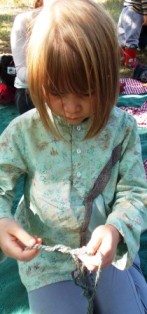
During snack time, the parents and children learned how to finger-knit a chain with yarn, in case they wanted to turn their golden silk into a cape.
After our snack, we hiked back to the front of the farm, where we found our goldenrod flowers just right for straining. If you are doing this at home, I recommend simmering the flowers for at least an hour and then letting them sit overnight before straining. We strained the flowers out of the pot and added a couple of tablespoons of alum. You can get alum from a dyeing supply company or the grocery store, and it acts as a mordant to fix the color into the fabric. It also magically transforms the brownish-golden water into a bright, clear yellow!
Time for the silks to go in. The silks have been washed and are re-dampened before they go into the pot. I purchased these 35” silk hemmed squares from Dharma.
The silks instantly become a beautiful golden yellow!
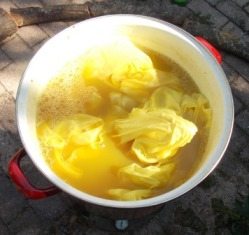
After the excitement of seeing white silks turn yellow, the children were ready to go with Farmer Jay to visit the chickens.
While they were visiting the hens, I removed the silks from the pot and rinsed them all in cold water until the water ran clear. Then I wrung them out and hung them to dry on the clothesline.
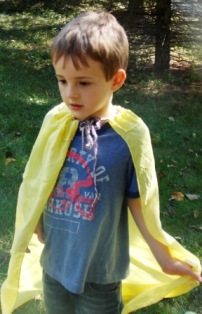
To transform the silk square into a cape, one only needs to machine-sew or hand-sew a sleeve on one end of the silk and run a finger-knitted chain through the sleeve for a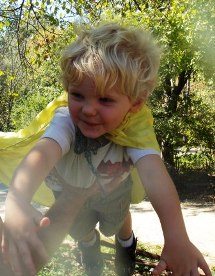 tie. Instant knight (as picture to left displays)…or super hero (see picture to right)!
tie. Instant knight (as picture to left displays)…or super hero (see picture to right)!
Amazingly, even though I never introduced the story of St. George and the Dragon to the children, the moment they tied on their golden capes, they began to run and shouted, “I’m a dragon! I’m a knight!” Hmmmm. Maybe there is an age-old wisdom here that does not need a puppet play to bring it to life.
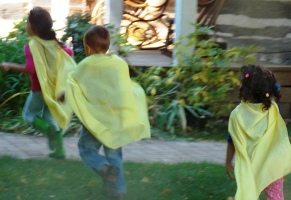
Mary is the director of the LifeWays Early Childhood Center in Milwaukee, WI, the director of the LifeWays training in Wisconsin, and a member of the Board of LifeWays North America.
We thank you for stopping by to enjoy this article. If you would like to share your experiences working with children in a LifeWays home or center, please feel free to contact Mara Spiropoulos at linearmara@gmail.com. She would be thrilled to work with you to share your wisdom and experiences on the LifeWays blog.
